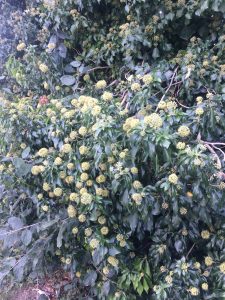by
Roland Hughes
12th October 2021

Ivy, Hedera helix, has a bit of a chequered reputation. A lot of people hate it and want to rip it off trees or ‘band it’ – cut a section away near the base of the host tree so that the aerial sections die. It does add mass and increase the ‘sail area’, i.e. the amount of foliage that can be blown around in the winter storms.
On deciduous trees this can make the difference between standing and not – especially when the wind comes from an unusual direction. Its wrapping habit means that when it has wound its tendrils around a branch (or trunk) there is no room for that branch to grow, weakening or deforming subsequent growth. And that is actually one of its good points. Those deformed branches are sought out by walking-stick makers for their characteristic spiral patterns.

At the moment, as the days shorten and the migrating species think about shooting off to warmer climes, ivy is smothered in flowers. You can really smell the pollen as you walk past hedges or fences with rampant ivy in or amongst the supporting plants.
Above the smell is the sound of bees (and other useful pollinators) humming busily away, getting a final harvest before winter sets in. Notable amongst these is the ivy bee, Colletes hederae, which has pronounced yellow stripes and is sometimes mistaken for a wasp.
It is one of the plasterer bees, a group of solitary bees that nest in burrows in the soil, lining it with a cellophane-like substance that protects it from water, fungi and other unwanted threats.

Not many native plants around over the next few weeks and months, and not that many exotics in the garden, will have this rich nectar source. Ivy is extending the ability of the insects to forage and survive or prepare for winter hibernation – Peacock butterflies for instance. Ivy, being evergreen and not requiring too much light, grows under other plants, in shady corners and on the ground.
It provides physical shelter for insects, birds and small mammals throughout the year but especially in winter. Beneath the leaves, temperature and humidity staying fairly constant, acting as home or larder depending on your needs.
Early in the new year the fruit, dark berries in clusters (looking a bit like the playground Jacks game, but denser) will be food, potentially a lifeline in the “hunger gap” for some of our native birds such as Blackbirds, Thrushes and Wood Pigeons, when many other berries have been stripped from the hedgerows.
Apparently, the wearing of a wreath of ivy around your head will prevent you from getting drunk. It has also been linked to intellectual prowess – winners of poetry competitions in ancient Rome were crowned with ivy wreaths. And of course, there’s a song about it and its fellow native evergreen – the Holly.
